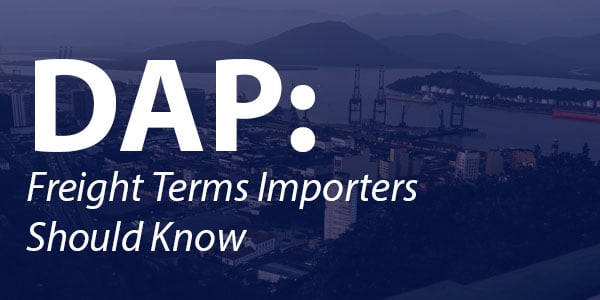
Importing and exporting carries risks, but who bears those risks depends on the chosen Incoterm.
On January 1, the International Chamber of Commerce released an updated publication of Incoterms. The 2020 revision to the authoritative text of international terms of trade counts the DAP rule among its 11 trade terms.
The DAP rule, first introduced in 2010, replaces the term Delivery Duty Unpaid. DAP falls amid a mix of regulations that includes Ex Works (EXW), which puts the least responsibility on sellers, and Delivered Duty Paid (DDP), which puts the most responsibility and risk on sellers.
DAP, short for Delivered at Place, makes sellers responsible for all charges and risks in transit until goods reach an agreed-upon destination, at which point buyers assume responsibility for their shipments.
Before selecting DAP for international trade, it behooves sellers and buyers to gain a clear understanding of counter-party responsibilities. Researching how DAP works and the advantages and disadvantages helps establish trade deals that benefit both parties.
Looking for more on DDP vs DAP? Check out this (B)logistics exclusive video!
What is DAP?
DAP refers to a trade deal where sellers agree to cover all costs, take on all risks, and absorb any potential losses of moving goods to a set location.
The contract makes sellers responsible for packaging, documentation, export approval, unloading charges, and delivery to an agreed-upon destination, whether a port, factory, or warehouse.
Cost and risk transfer to buyers when goods arrive at their destination and become available for unloading. Buyers then cover unloading costs, pay import duties and applicable taxes, and supply documentation to clear Customs and import goods into the named country of destination.
DAP works well for intermodal shipping because the agreements allow any transport mode, whether shipping by ocean, rail, air, or land. A DAP agreement applies to any form or combination of forms of transportation.
DAP Advantages and Disadvantages
If your U.S. firm buys widgets from a company in Japan and enters a DAP agreement, the seller takes on the risk of getting goods to the United States. The supplier raises the price for each widget to reflect its cost from packaging to arrival at the Port of Los Angeles, for example.
The DAP advantage is that the supplier takes on risks during transport. If containers fall off in rough seas, the seller pays to replace the goods.
However, there are times when DDP makes more sense. Here, a seller pays to transport goods from packaging to unloading in a buyer's warehouse, including Customs fees. But the buyer pays more per widget, which might cost $6 instead of $3. This works well for smaller customers who don't want to assume any responsibility for getting goods from Point A to Point B but not for buyers purchasing thousands of widgets weekly.
There is also an element of trust involved with DDP. Buyers must assume sellers got the best transport deal. DAP gives buyers more control over costs than DDP because they pay to move their goods from the port to their warehouse.
Most goods today ship as FOB (the seller's location). Under this trade deal, as soon as the shipment leaves the seller's warehouse, the seller records the sale as complete. The buyer takes over ocean freight, air freight, et cetera, which gives them more control and visibility into their shipments.
DAP lowers a buyer's risk. There's no risk when goods are on the water, in the air, or transferred across land. The buyer only assumes risk when goods arrive in port. Here, they must handle Customs clearance, ISF, Customs errors, et cetera.
If the buyer identifies the delivery location, the DAP rule works well. Sellers deliver the goods, and Customs clears them quickly. However, complications arise when goods go through a clearance point before delivery. Here, clearing goods requires a close partnership between the carrier and the buyer. When things go awry, delays and disputes over demurrage can occur.
The buyer also assumes a loss of control with DAP, which can be a disadvantage. Buyers must rely on their suppliers to provide updated sailing schedules or get air freight on a plane. Companies cite cases where suppliers haven't given timely updates, and they do not know when their shipments will arrive.
Get the Best DAP Deal
DAP offers a way to reduce the risk for buyers as they import goods. The agreements also introduce an element of risk. However, there are ways to lower risk for both parties in a DAP agreement.
- Set Delivery Dates: Delivery must occur on an agreed-upon date. Demurrage happens when goods cannot unload on time because one party did not receive proper clearance. The fault lies with the party that failed to provide timely documentation, but figuring out which party to blame is tricky. If buyers cannot clear goods, they bear the risk and the costs of goods sitting in Customs' control.
- Agree Upon a Destination: Another common mistake is the agreed-upon destination. Most sellers deliver goods to the buyer's premises under DAP. But not always. Buyers and sellers need to pinpoint the destination. Buyers might select a port, a container terminal, a new factory, or somewhere else for delivery. Buyers bear all risks for loss or damage once sellers deliver the goods. Should buyers fail to notify sellers about where to deliver goods or submit necessary Customs paperwork, they pay the costs for goods held in port.
- Import-Clear the Goods: Customs will hold goods in a bonded warehouse or terminals until buyers submit needed paperwork. It's crucial to prepare Customs documents before the goods arrive. Incorrect paperwork delays clearance and leads to detention and demurrage fines that buyers must pay.
- Decide Whom Will Insure the Goods: Insuring goods is a concern. Though sellers assume the risk of loss or damage until delivery, DAP does not mandate that sellers insure shipments. Also, the contracts do not obligate buyers to insure goods. It's a best practice to insure every shipment, so determine which party will do so before entering a DAP agreement.
DAP divides risk into two basic categories: Before goods get to their destination and once they arrive. These contracts can be a win-win for all parties involved when buyers and sellers understand each other's responsibilities. However, when dealing with the minutia of Incoterms and Customs compliance, it's best to consult with a qualified Customs broker to go over your options.



